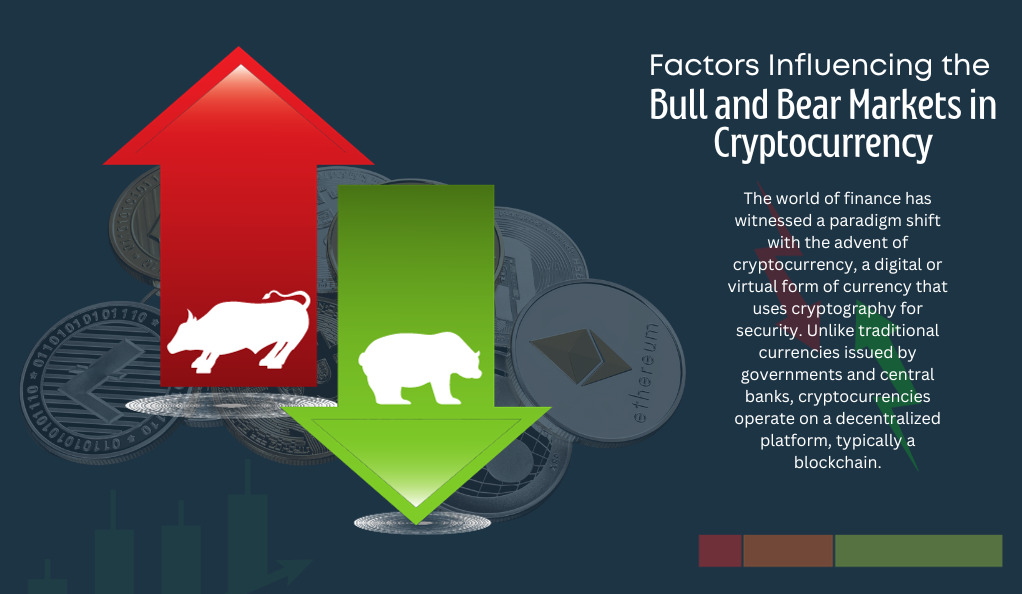The world of finance has witnessed a paradigm shift with the advent of cryptocurrency, a digital or virtual form of currency that uses cryptography for security. Unlike traditional currencies issued by governments and central banks, cryptocurrencies operate on a decentralized platform, typically a blockchain. This introduction aims to provide a foundational understanding of cryptocurrency and the factors that have contributed to its meteoric rise, as well as the challenges it faces.
What is Cryptocurrency?
Cryptocurrency, often simply referred to as ‘crypto’, is a digital currency designed to function as a medium of exchange. It operates independently of a central authority, such as a government or bank. The name “cryptocurrency” is derived from the encryption techniques used to secure transactions and control the creation of new units.
Table 1: Basic Cryptocurrency Terminology
| Term | Description |
|---|---|
| Blockchain | A continuously growing list of records, called blocks, linked and secured using cryptography. |
| Mining | The process of validating and recording transactions on the blockchain. |
| Decentralized | Not controlled by any single entity or institution. |
| Token | A representation of a particular asset or utility on a blockchain. |
| Wallet | A digital tool that allows users to store and manage their cryptocurrency. |
The Rise of Bitcoin and the Crypto Revolution
Bitcoin, introduced in 2009 by the pseudonymous developer Satoshi Nakamoto, is often credited as the first decentralized cryptocurrency. Its creation was rooted in the idea of establishing a currency free from government intervention and banking fees. The underlying technology, blockchain, ensured transparency and security, making it resistant to fraud and counterfeiting.
Following Bitcoin’s introduction, the digital currency landscape exploded with innovation. As of June 2023, there were over 25,000 different cryptocurrencies in the market, with many offering unique functionalities and use-cases beyond mere currency, such as smart contracts and decentralized applications.
Historical Context
The journey of cryptocurrency, while relatively short in the grand timeline of financial history, has been nothing short of dramatic. To understand the current state of the crypto market, it’s essential to look back at its major milestones and the events that have shaped its trajectory.
Major Milestones in Cryptocurrency History
- 2009: Introduction of Bitcoin by Satoshi Nakamoto. This marked the birth of the first decentralized cryptocurrency.
- 2013: Bitcoin surpasses the $1,000 mark for the first time, drawing significant media attention and public interest.
- 2017: A landmark year for crypto, with Bitcoin reaching an all-time high of nearly $20,000 in December. This year also saw the rise of Initial Coin Offerings (ICOs) as a popular fundraising method.
- 2020: The decentralized finance (DeFi) movement gains momentum, offering a suite of financial services without traditional intermediaries.
- 2022: Major institutional investors and corporations begin to adopt and endorse cryptocurrency, signaling its growing mainstream acceptance.
Past Bubbles and Market Crashes
The crypto market is known for its volatility. Over the years, it has experienced several bubbles, followed by significant corrections. Some notable instances include:
Key historical events have marked the cryptocurrency market’s journey. In 2011, Bitcoin experienced its first major crash, plummeting from $32 to just a few cents in a matter of months. 2014 witnessed the infamous Mt. Gox incident, as the largest Bitcoin exchange declared bankruptcy, causing a market crash. In 2018, following the 2017 highs, the crypto market endured a prolonged bear phase, with Bitcoin shedding over 80% of its value from its peak. These events serve as significant milestones in the volatile and ever-evolving world of cryptocurrencies.
Significant Events Shaping the Crypto Landscape
Several events have had profound impacts on the perception and value of cryptocurrencies:
- Regulatory crackdowns: Governments around the world have occasionally taken strict measures against crypto, leading to market jitters.
- Technological advancements: Innovations like the Lightning Network for Bitcoin have influenced adoption rates and market sentiment.
- Macro-economic factors: Global economic downturns, geopolitical tensions, and monetary policies have often influenced crypto as an alternative investment.
Technological Factors
Cryptocurrency’s very existence and functionality are deeply rooted in technology. The intricate web of algorithms, protocols, and systems underpinning these digital assets plays a pivotal role in influencing market dynamics. Let’s delve into some of the key technological factors that shape the bull and bear markets in cryptocurrency.
Blockchain: The Backbone of Cryptocurrency
Blockchain technology is the foundation upon which most cryptocurrencies are built. It offers a decentralized ledger of all transactions across a network, ensuring transparency and security. Key features of blockchain include:
- Immutability: Once data is recorded on the blockchain, it cannot be altered, ensuring trustworthiness.
- Decentralization: Transactions are verified by network participants, eliminating the need for intermediaries.
- Transparency: All transactions are visible to anyone within the network, promoting accountability.
Proof-of-Work vs. Proof-of-Stake
The consensus mechanisms, primarily Proof-of-Work (PoW) and Proof-of-Stake (PoS), have a significant influence on market dynamics:
Proof-of-Work (PoW): Cryptocurrencies like Bitcoin use PoW, where miners solve complex mathematical problems to validate transactions and create new blocks. This process is energy-intensive, leading to concerns about environmental impact and sustainability.
Proof-of-Stake (PoS): An alternative to PoW, PoS allows users to create blocks and validate transactions based on the number of coins they hold. It’s seen as a more energy-efficient method, and its adoption can influence market sentiment positively.
The Impact of Mining
Mining is the process by which new cryptocurrency coins are introduced into the market. The dynamics of mining, such as the halving events in Bitcoin, can have profound effects on supply and demand:
In the cryptocurrency realm, halving events, which involve the halving of mining rewards for new blocks, serve as periodic occurrences. These events decrease the rate of new coin creation, often resulting in heightened demand and subsequent price surges. Additionally, the expenses linked to cryptocurrency mining, encompassing energy usage and hardware costs, can significantly impact miners’ profitability and, in turn, influence market supply dynamics.
Technological Advancements and Integration
The continuous evolution of technology in the crypto space can act as a catalyst for market movements:
- Layer 2 solutions: Technologies like the Lightning Network for Bitcoin aim to improve scalability and transaction speeds, enhancing user experience and adoption.
- Interoperability: Efforts to enable different blockchains to communicate and interact can expand the utility and appeal of cryptocurrencies.
Regulatory and Governmental Influences
The relationship between cryptocurrencies and governmental bodies has always been complex. As digital assets grow in popularity and adoption, regulatory stances and decisions play an increasingly significant role in shaping the market’s direction.
Global Regulatory Landscape
Different countries have adopted varied approaches to cryptocurrency:
- Embracing: Nations like Switzerland and Malta have established themselves as crypto-friendly hubs, creating regulatory frameworks that foster innovation and attract businesses.
- Cautious: Countries such as the United States and the United Kingdom have taken a more measured approach, seeking to strike a balance between innovation and consumer protection.
- Restrictive: Some nations, like China, have imposed strict bans on cryptocurrency trading and Initial Coin Offerings (ICOs), citing concerns over financial stability and capital flight.
Impact of Regulations on Market Dynamics
Regulatory decisions can have immediate and profound impacts on the crypto market:
- Positive sentiment: Clear and supportive regulations can boost investor confidence, leading to increased adoption and bullish market trends.
- Uncertainty: Ambiguous or pending regulatory decisions can create uncertainty, leading to market volatility and reduced investor participation.
- Market exits: Strict regulations or bans can lead to significant market downturns as investors and businesses exit the market or relocate to more crypto-friendly jurisdictions.
Taxation and Cryptocurrency
Tax treatment of cryptocurrency gains is another crucial regulatory aspect that influences investor behavior:
Capital gains: In many jurisdictions, cryptocurrency is treated as property, and capital gains tax applies to its sale or exchange.
Transaction reporting: Some countries require individuals and businesses to report cryptocurrency transactions, affecting the ease of use and adoption.
Central Bank Digital Currencies (CBDCs)
The rise of cryptocurrencies has prompted several central banks to explore the issuance of their digital currencies:
The perception of Central Bank Digital Currencies (CBDCs) varies, with some seeing them as potential rivals to decentralized cryptocurrencies and others envisioning them coexisting, each fulfilling distinct roles. Furthermore, the introduction of a CBDC can exert significant influence on the broader crypto market, potentially validating the concept of digital currencies or diverting attention away from decentralized alternatives, depending on how they are implemented and adopted.
Economic Implications
Cryptocurrencies, while technological marvels, are also deeply intertwined with global economic systems. Their rise, adoption, and market behavior are influenced by various economic factors, from transaction fees to the broader macroeconomic environment.
Transaction Fees and Block Rewards
The economic model of many cryptocurrencies revolves around transaction fees and block rewards:

- Transaction Fees: Users often pay fees to prioritize their transactions on the network. These fees can fluctuate based on network demand, affecting the usability of a cryptocurrency.
- Block Rewards: Miners or validators receive rewards for adding new blocks to the blockchain. As these rewards diminish over time (e.g., Bitcoin halvings), they can influence the supply dynamics and, consequently, the price.
Cryptocurrency Exchanges and Arbitrage
Exchanges play a pivotal role in the crypto ecosystem:
- Liquidity Providers: Exchanges facilitate the buying and selling of cryptocurrencies, providing liquidity to the market. The entry or exit of major exchanges can significantly impact market sentiment and prices.
- Arbitrage Opportunities: Price discrepancies between exchanges can lead to arbitrage opportunities, where traders buy low on one exchange and sell high on another. This activity can influence price stability and volume across platforms.
Global Economic Factors
The broader economic environment can sway the crypto market:
Cryptocurrencies, notably Bitcoin, are frequently seen as a hedge against inflation and fiat devaluation, with increased demand during such economic conditions. Central bank policies, particularly those affecting interest rates, can significantly impact the appeal of alternative assets like cryptocurrencies, as they influence the relative attractiveness of these assets compared to traditional financial instruments.
Geopolitical Events
Major global events can act as catalysts for cryptocurrency market movements:
Economic Sanctions: In countries facing international sanctions, cryptocurrencies can become a means to bypass traditional financial systems.
Political Instability: In regions with political unrest or instability, cryptocurrencies can serve as a safe haven or a means to transfer wealth discreetly.
Adoption as a Medium of Exchange
The acceptance of cryptocurrencies for everyday transactions can influence their demand:
- Merchant Adoption: As more businesses accept cryptocurrencies, their utility and demand can increase, positively impacting the market.
- Remittances: In countries with expensive or inaccessible remittance services, cryptocurrencies can offer a cheaper and faster alternative, driving demand.
External Events and Market Sentiment
The cryptocurrency market, known for its volatility, is not just influenced by internal factors like technology and economics. External events and the prevailing market sentiment play a substantial role in driving price movements and adoption trends.
Global Events and Their Impact
Various global occurrences can have a direct or indirect influence on the crypto market:

- Pandemics: Events like the COVID-19 pandemic can lead to economic downturns, prompting investors to seek alternative assets, including cryptocurrencies, as potential safe havens or investment opportunities.
- Technological Breakthroughs: Innovations outside the direct realm of crypto, such as advancements in quantum computing, can pose threats or opportunities to the security and viability of cryptocurrencies.
- Environmental Concerns: The environmental impact of cryptocurrency mining, especially for Proof-of-Work coins, can lead to public outcry, influencing market sentiment and regulatory decisions.
Media Influence and Public Perception
The portrayal of cryptocurrencies in the media can significantly sway public opinion:
Positive Coverage: Reports highlighting the potential benefits, use-cases, or successful adoption stories can spur interest and drive bullish trends.
Negative Coverage: Stories focusing on the darker side of crypto, such as scams, hacks, or environmental concerns, can deter potential investors and lead to bearish market movements.
Celebrity Endorsements and Influencer Opinions
In today’s digital age, influencers and celebrities wield considerable power:
- Endorsements: When prominent figures voice their support for or invest in cryptocurrencies, it can lead to increased interest and adoption, driving up prices.
- Criticism: Conversely, skepticism or negative remarks from influential personalities can dampen enthusiasm and impact market sentiment.
Market Speculation and Fear of Missing Out (FOMO)
The crypto market is not immune to speculative behaviors:
Cryptocurrency markets are susceptible to speculative bubbles, characterized by rapid price increases fueled by speculation rather than underlying value, which can result in unsustainable market conditions. Additionally, the phenomenon of FOMO, or Fear of Missing Out, can exacerbate price volatility as rising prices and heightened media coverage prompt more investors to join in, driven by the fear of missing out on potential gains.
Future Outlook
As we venture further into the digital age, the trajectory of cryptocurrencies remains one of the most debated topics in the financial world. While the past has been marked by rapid innovations, regulatory challenges, and fluctuating market dynamics, the future holds its own set of possibilities and uncertainties.
Potential Technological Advancements
The crypto space is ripe for continuous innovation:

- Scalability Solutions: As cryptocurrencies gain more users, the need for scalable solutions becomes paramount. Technologies like sharding or off-chain transactions could address these challenges.
- Enhanced Privacy Features: With growing concerns about data privacy, we might see the rise of cryptocurrencies offering more robust privacy features, making transactions untraceable and anonymous.
- Smart Contract Evolution: The utility of smart contracts is expected to grow, with more sophisticated and varied applications across industries.
Regulatory Evolution
As the crypto industry matures, so will its regulatory landscape:
Standardized Global Regulations: There’s potential for the development of standardized regulations across countries, fostering a more harmonious global crypto ecosystem.
Consumer Protection Measures: As more people invest and transact in cryptocurrencies, regulatory bodies might introduce more stringent consumer protection measures.
Integration with Traditional Finance
The lines between traditional finance and cryptocurrencies are expected to blur:
- Banking and Crypto: More banks might offer cryptocurrency-related services, from trading platforms to custody solutions.
- Crypto-backed Financial Products: The future might see a rise in crypto-backed financial products, such as ETFs or bonds, bridging the gap between traditional finance and digital assets.
Conclusion
Cryptocurrencies, once a niche technological curiosity, have firmly cemented their position as formidable players in the global financial landscape. Their journey, marked by innovation, challenges, and evolving dynamics, underscores their potential to redefine traditional financial systems.
As we look to the future, the fusion of technology, regulatory evolution, and societal adoption promises a transformative impact, not just on finance but on various sectors of the global economy. It’s evident that the ripple effects of the crypto revolution will be felt for decades to come, shaping a new era of decentralized and digital financial interactions.





